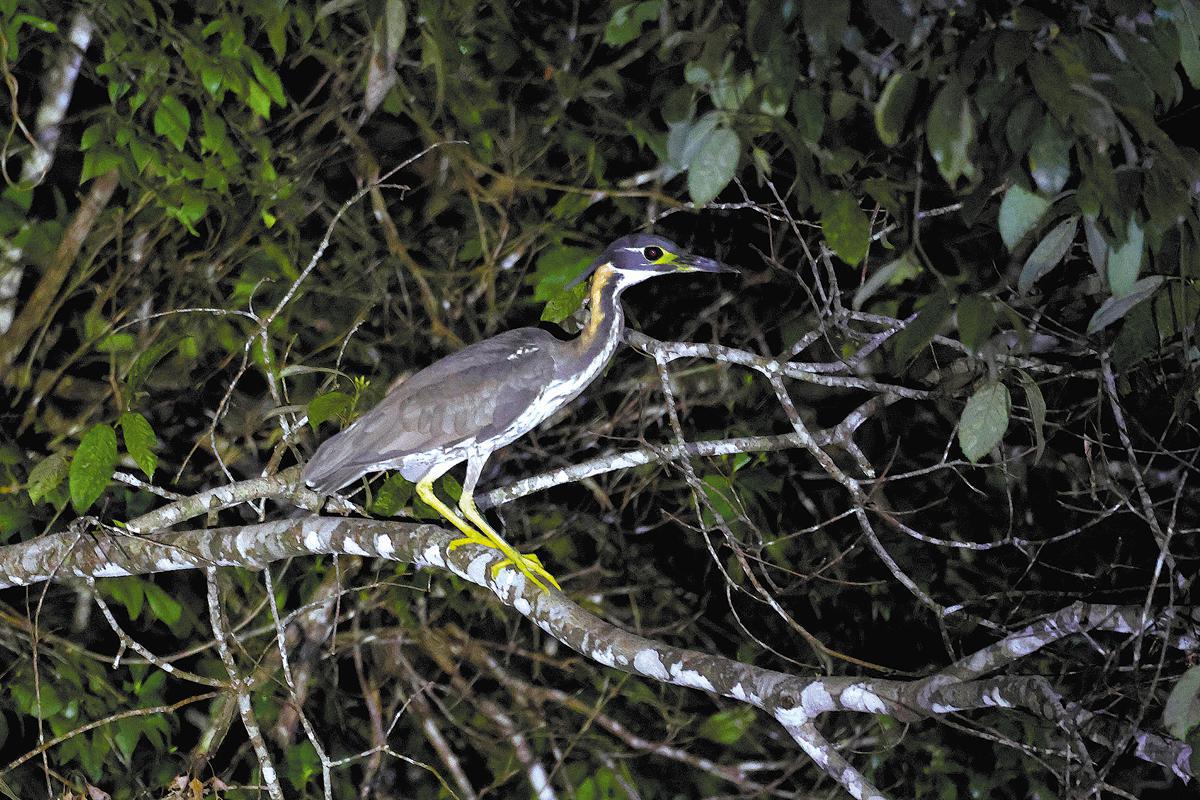
Xie Fanglin (second from right) guides bird-watchers and photographers to spy night herons at a reservoir near Zhongxi village on March 20. CHEN LIANG/CHINA DAILY
Last month, Carrie Ka-wai Ma received a WeChat message informing her of a unique opportunity to observe elusive white-eared night herons at a reservoir near Zhongxi village in Fujian province.
"It was wonderful news," said Ma, an ardent bird-watcher who works with Hong Kong Wetland Park on exhibit planning and who is also an amateur bird ringer.
The message was from Xie Fanglin, a birdwatching guide based in Mingxi county, Fujian, who had previously guided her around his hometown.
"I immediately started planning a trip to Mingxi county," Ma said.
The white-eared night heron is not a new bird for the experienced birder. Primarily found in southern China and northern Vietnam, it is a nocturnal and exceptionally elusive species. Due to its rarity, the International Union for Conservation of Nature Red List classifies it as endangered, because its population is small, fragmented and in decline.
Ma is among the few Chinese bird-watchers who have previously seen this mystical bird. Her first sighting was in 2003 at Chebaling National Nature Reserve in Guangdong province, where she glimpsed a black silhouette against the dusk sky. In the summer of 2017, she traveled to the Xin'anjiang Reservoir in Zhejiang province, where local birders had discovered pairs of the nesting herons.
"However, I never had the chance to observe their nocturnal behaviors," she said.
Once her plans were made, Ma and two birding friends boarded a bullet train from Shenzhen in Guangdong province to Zhangzhou in Fujian on the morning of March 7, then transferred to another train to Sanming city.
They met Xie at the station and he drove them to Zhongxi, arriving in late afternoon to watch Elliot's pheasants at Xie's bird hide.
That evening, Xie guided Ma and her friends, along with several other customers, into the depths of the reservoir on an electric pontoon.

A white-eared night heron perches on a branch in Mingxi county, Fujian province, on March 7. CARRIE KA-WAI MA/FOR CHINA DAILY
Each bird-watcher had a chair and space to set up a camera tripod. Xie's partner operated the boat while Xie sat at the front, navigating and searching for white-eared night herons with a torchlight.
Scanning the muddy banks and shoals with his torch, Xie spotted at least four white-eared night herons over two hours. "We saw two birds feeding on the bank before flying into the trees," Ma said.
Ma said that the reservoir is part of a river and riparian forests grow on its banks.
"From my observation, the water is very clean and the place has minimal human interference, very similar to the habitat I saw in the Xin'anjiang Reservoir," she said.
"There are tall trees with dense canopies which serve as good nesting habitats for the birds. Near the reservoir, there are also farms for them to find food. So this area could be a significant breeding site for the herons."
Xie concurred with Ma's observations. In fact, the bird-watching guide started searching for the night herons because a bird photographer accidentally took pictures of a juvenile white-eared heron near Zhongxi in May 2022.
"The presence of a juvenile indicated the bird might have been born here," Xie said. He explored habitats around the village, notably the woods near rivers, and eventually discovered the herons on the reservoir banks during a night watch.
"I realized it was almost impossible to find the birds during the day," he said. "But at night, they reliably appeared at the reservoir."
After locating the birds, Xie sought the best way to bring his guests into the heart of the reservoir safely and comfortably.
"I spent two years testing different boats to find the best one," Xie shared. "I tried several types, including fishing platforms and rubber boats, before designing our current pontoon boat."
Tours on the pontoon boat, stable and quiet, quickly became a hit within the birding community. "So far, I've welcomed 600 to 700 guests," Xie said.
For Ma, the two-hour night tour yielded not only sightings of the night herons but also 15 red-backed flying squirrels and several other bird species.
"It was truly satisfying," she said. "Mingxi is such a wonderful place for bird-watching. I am sure I will visit again."
chenliang@chinadaily.com.cn